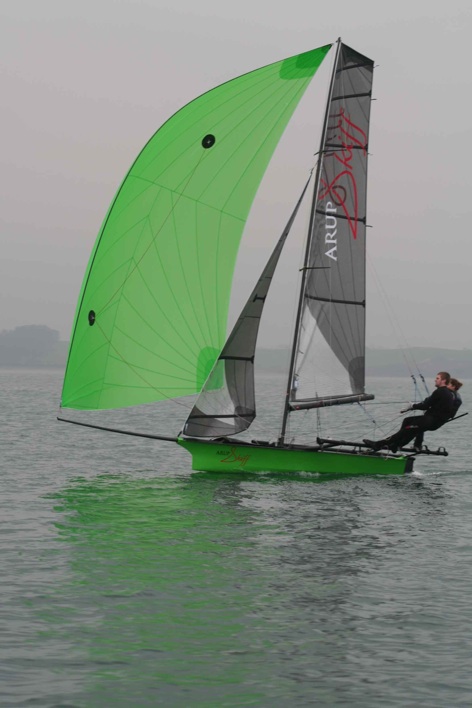This Saturday the International Sailing Federation (ISAF) will be running a week long trial to select the new women’s skiff for the 2016 Olympics. They are looking for a boat that is a test of skill rather than strength, is fun to sail and to watch and is affordable and accessible for ‘grass roots’ sailors.
We need to remember that few things are ‘invented’ nowadays and that more value can be had by redeploying technology and processes from one industry into another
I’m pleased to say that we (Arup) have entered a boat known as the Arup Skiff into these trials. Arup’s input has been to the structural design; the hydrodynamic design (i.e. the shape) is by the hydrodynamicist Kevin Ellway. This is exciting, firstly because I think we are a strong contender but secondly because the Arup Skiff is a fine example of technology transfer. It’s a carbon fibre composite construction and though we haven’t designed a lot of boats, we do have a great deal of experience of carbon fibre in other contexts. We have used it to strengthen buildings and bridges, for light weight demountable structures and for geometrically complex sculptures that could not be realized any other way. We have also developed methods of analysing the non-linear performance of carbon fibre for our work on high end sports cars. So actually, it seems quite logical that we would apply this experience to the structural design of boats.

Many examples of engineering innovation are more fundamentally examples of technology transfer. Gore-tex, non-stick frying pans and low friction bearings are all different applications of PTFE, ABS came from aircraft and the CAN bus was developed in the automotive industry but is now being used in medical devices and industrial control applications. In my own field we’ve used noise, vibration and harshness methods from the automotive industry to predict radiated noise from high speed railway bridges, and non-linear analysis techniques typically used for vehicle crashworthiness have been used to assess the performance of buildings in earthquakes. ETFE was originally developed as an insulation product for the aerospace industry and has now been used as cladding on a number of buildings including The Eden Project and Beijing’s Water Cube.
So when we talk about the need for innovation in industry we need to remember that few things are ‘invented’ nowadays and that more value (and less risk) can be had by redeploying technology and processes from one industry into another. But how can we make more of this happen, and what prevents it currently? Many years ago Adam Smith observed that increasing scale leads to a greater division of labour and a more specialist workforce. The complexity of many modern day systems has a similar, compounding effect and the end result is that many of our engineers now specialize relatively early in their career and gain little experience outside of their own area. We do need specialists and cutting edge research projects but we also need to promote and encourage ‘generalist’ engineering career paths - people who move around and take ideas from one domain into another. The specialist route is well supported by research councils and to some extent market forces, but there are few policy initiatives that I am aware of that promote the generalist path.
We need to promote ‘generalist’ engineering career paths — people who move around and take ideas from one domain to another
Many governments are supporting industry in these difficult financial times through reduced hours schemes – the objective of these is to ensure that firms retain talented staff for when the market picks up. We do not have such a scheme in the UK, but a variant of it, which supported engineers transferring from a struggling industry to one that is booming or suffering from skill shortages (e.g. rolling stock to automotive), could be considered. The Institutions could do more, by encouraging chartership applicants to demonstrate diversity of project experience. Universities could be encouraged to substitute engineering science degrees for single discipline ones, or at the very least ensuring that the first one or two years are ‘general’.
Our skiff – and the business model for its delivery – are different from the other 5 entrants. If we are selected then we will claim to have an innovative structural design. In truth, it will only be innovative in that context as there is nothing in our design or business model that has not been done previously elsewhere. I hope that, as a profession, we can find ways to encourage this transfer at all levels. Google Arup Skiff to see how we are getting on.





Glasgow trial explores AR cues for autonomous road safety
They've ploughed into a few vulnerable road users in the past. Making that less likely will make it spectacularly easy to stop the traffic for...